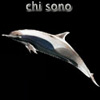
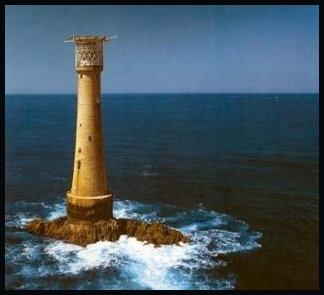


|
|
|
|||||||||||||||||||
|
|
||||||||||||||||||||
|
|
STORIE DI FARI THE LIGHTHOUSE OF GENOA Articolo pubblicato sulla rivista americana Lighthouse Digest - Novembre 2009 (Segue testo originale) 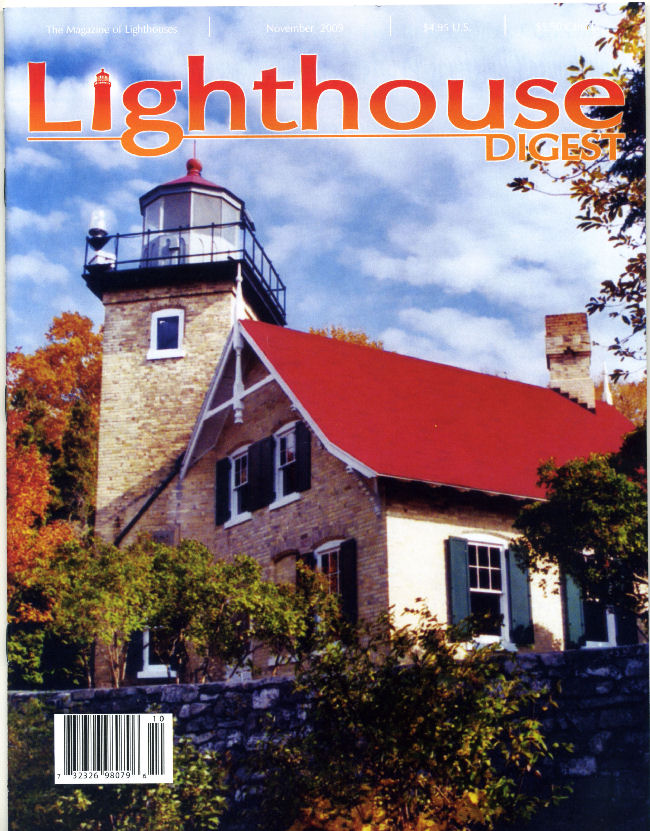 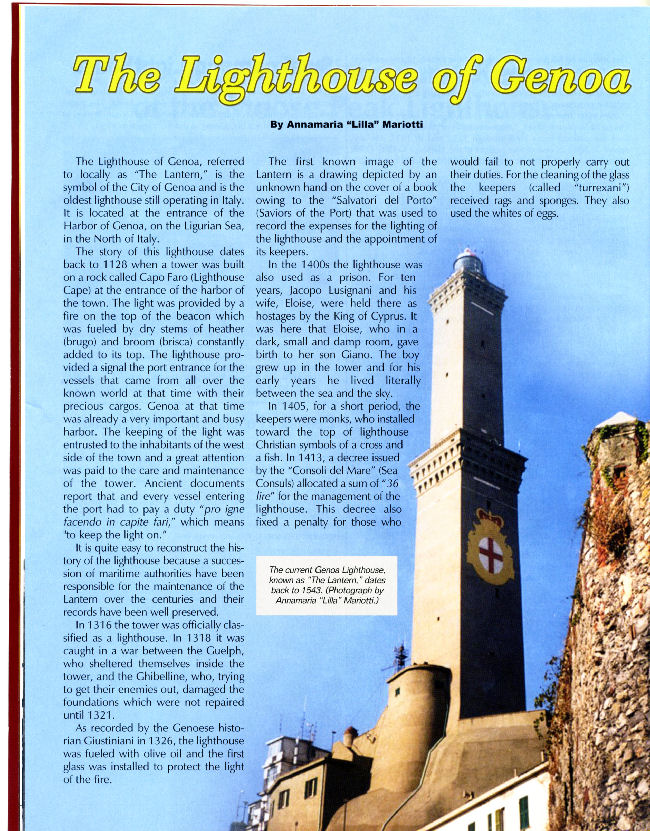 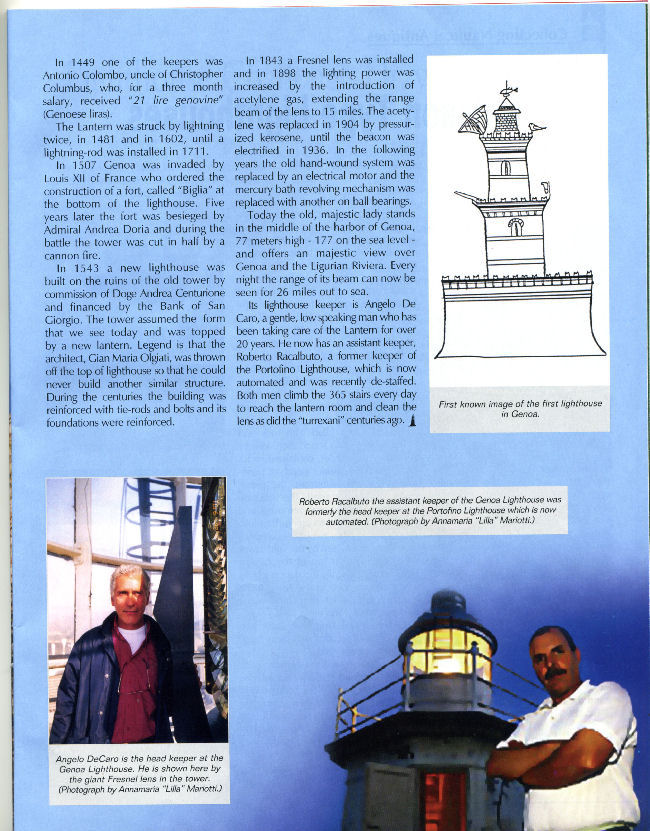 TESTO ORIGINALE THE LIGHTOUSE OF GENOA - LIGURIA, ITALY By Annamaria “Lilla” Mariotti The lighthouse of Genoa, friendly called “The Lantern” because it is the symbol itself of the city and is the oldest still operating in Italy. It is located at the entrance of the harbor of Genoa, on the Ligurian sea, in the North of Italy. The story of this lighthouse dates back to 1128 when a tower was built on a rock called Capo Faro (Lighthouse Cape) at the entrance of the harbor of the town. The fire was provided on the top fueled by dry stems of heather (brugo) and broom (brisca) constantly added to its top to signal the port entrance to the vessels that came from everywhere with their precious cargo of merchandises. Genoa at that time was already a very important and busy harbor. The keeping of the light was entrusted to the inhabitants of the west side of the town and a great attention was paid to the care and maintenance of the tower. Ancient documents report that and every vessel entering the port had to pay a duty “pro igne facendo in capite fari” that it means to keep the light on. It is quite easy to reconstruct the story of this lighthouse because a succession of maritime authorities have been responsible for the maintenance of the Lantern over the centuries and their records tell us the story of this light. In 1316 the tower was officially denominated a lighthouse and in 1318 was caught in a war between the Guelph, who sheltered themselves inside the tower, and the Ghibelline who, trying to get their enemies out, damaged the foundations which were not repaired until 1321. As recorded by the Genoese historian Giustiniani in 1326 the lighthouse was fueled with olive oil and were installed the first glasses to protect the fire. These glass were manufactured by a Ligurian firm on the hills. The first image we have of the lantern is a pen drawing depicted by an unknown hand on the cover of a book owing to the “Salvatori del Porto” (Saviors of the Port) that was used to record the expenses for the lighting of the lighthouse and the appointment of the keepers. In the 1400’s the lighthouse was also used as a prison and for ten years was kept there the hostage of the king of Cyprus, Jacopo Lusignani, with his wife, Eloise, who in a dark, small and damp room gave birth to her son Giano. The boy grew up in the tower, suspended between sea and sky, maybe scared by the loud sound of the waves at the bottom and the storms on the top. In 1405, for a short period, the keepers were monks, who put on the top Christian symbols, like a cross and a fish. In 1413 a decree issued by the “Consoli del Mare” (Sea Consuls) allocated a sum of “36 lire” for the management of the lighthouse, which in the meantime was considered essential for the safety of shipping, including also the wages for the keepers and fixing a penalty for those who had not properly carried their duties. For the cleaning of the glass the keepers (called “turrexani”) received rags, sponges and they used also the white of an egg. In 1449 one of the keepers was Antonio Colombo, uncle of the most notorious Christopher Columbus, who, for a three month salary, received “21 lire genovine” (Genoese liras). The Lantern was struck by lightning twice, in 1481 and in 1602, until a lightning-rod was installed in 1711. In 1507 Genoa was invaded by Louis XII of France who ordered the construction of a fort, called “Biglia” at the bottom of the lighthouse, which was besieged by the Admiral Andrea Doria five years later and during the battle the tower was cut in half by a cannon fire. The new lighthouse was built on the ruins of the old tower in 1543 by commission of the Doge Andrea Centurione and financed by the Bank of San Giorgio. The tower assumed the form that we can see today and was topped by a new lantern. A legend is that the architect who had designed the lantern, whose name was Gian Maria Olgiati, was thrown off its top so that he could never build another similar beautiful lighthouse. During the centuries the building was reinforced with tie-rods and bolts and its foundations were reinforced. In 1843 there were installed the Fresnel lens and in 1898 the lighting power was increased by the introduction of acetylene gas, extending the range beam of the lantern to 15 miles. The acetylene was replaced in 1904 by pressurized kerosene, until it was electrified in 1936. In the following years the old hand-wound system was replaced by an electrical motor and the mercury bath revolving mechanism was replaced with another on ball bearings. Today the old, majestic lady stands in the middle of the harbor of Genoa, 77 meters high – 177 on the sea level – and offers an incomparable view over Genoa and the Ligurian Riviera and every night the range of its beam can be seen for 26 miles on the dark sea. Its keeper is Angelo De Caro, a gentle, low speaking man who has been taking care of the Lantern for over 20 years. Now there is also an assistant keeper, Roberto Racalbuto, former keeper of the lighthouse of Portofino, now unguarded. They both climb every day the 365 stairs to reach the lantern and to keep it clean as did the “turrexani” centuries ago.
|
|
|
|
||
| Site Map |

